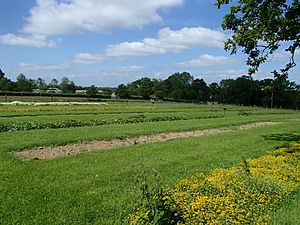UK Native Seed Hub facts for kids
Quick facts for kids The UK Native Seed Hub |
|
|---|---|

The UKNSH production beds, with the Millennium Seed Bank building behind
|
|
| Location | Sussex, England |
The UK Native Seed Hub (UKNSH) is a special project that helps protect wild plants in the United Kingdom. It is part of the Royal Botanic Gardens, Kew's Millennium Seed Bank Partnership. This project grows and shares seeds from plants that naturally grow in the UK.
The UKNSH is located at Wakehurst Place in West Sussex, England. Its main goal is to make sure there are enough good quality seeds for conservation projects. These projects help bring back plants in areas where they are disappearing. The UKNSH helps make nature stronger and more connected across the UK.
As part of the Royal Botanic Gardens, the UKNSH is a nonprofit organization. This means it does not aim to make money. It provides seeds under a special agreement. This ensures the seeds are only used for projects that help UK biodiversity. They charge a small fee to cover the cost of collecting new seeds.
Sometimes, the UKNSH also offers training and advice. This helps people learn how to use and store native seeds properly. It also helps other seed suppliers improve their knowledge.
Contents
How the UK Native Seed Hub Started
The UK Native Seed Hub began in 2011. The Esmée Fairbairn Foundation gave money to the Royal Botanic Gardens, Kew. This funding helped set up the project over four years.
Seed production started at the Wakehurst Place nursery in 2011. By 2012, the seed production moved to new beds. These beds are now open for the public to see at Wakehurst Place. The project first focused on growing seeds for grassland plants. Examples include Campanula rotundifolia (harebell) and Genista tinctoria (dyer's greenweed). These seeds came from the Millennium Seed Bank's collections.
In May 2014, the UKNSH made seeds available online. This allowed conservation projects to ask for seeds. They could choose from the available UKNSH collections.
The Seed Hub Site
The Seed Hub itself is the production area at Wakehurst Place. It has 28 growing beds. These beds cover about one hectare of land. The site is close to the Millennium Seed Bank building. Visitors can see it on the Wakehurst map.
Construction of the site began in 2011. Kew's gardening experts take care of the plants. They focus on growing seeds that are hard to find. This might be because they are difficult to harvest or grow.
Often, species are grown to create a large collection of seeds. These seeds come from a specific UK area, like the South Downs. An example is Primula veris (cowslip) from that region. The site is also a great place to watch and photograph plant pollinators.
The Seed List and How It Works
The UKNSH provides high-quality seeds from the Millennium Seed Bank. These seeds are from plants that originally grew in the UK. They are given to projects that help improve nature in the UK. Some seeds come from the production beds at Wakehurst Place. Others come directly from the Millennium Seed Bank.
Seeds are only given out if there are enough in the collection. If there are not enough seeds, the species might be grown on the production beds. This helps increase the number of seeds. All seeds provided are "F1" generation. This means they are the first offspring of plants grown from wild-collected seeds. The seed list is managed carefully. This ensures that giving seeds to projects will never completely empty the seed bank.
Support for Seed Users
The UKNSH also offers training for people who collect, grow, and use seeds. This training helps them understand why high-quality UK seeds are important. It also teaches them the skills needed to use the seeds correctly.
The support ensures that the right seeds are used for each project's location. It covers everything about handling seeds. This includes harvesting, processing, testing, storing, and sowing. The goal is to improve how native seeds are used in the UK. The UKNSH also gives advice and services. This helps the project continue its important work.

